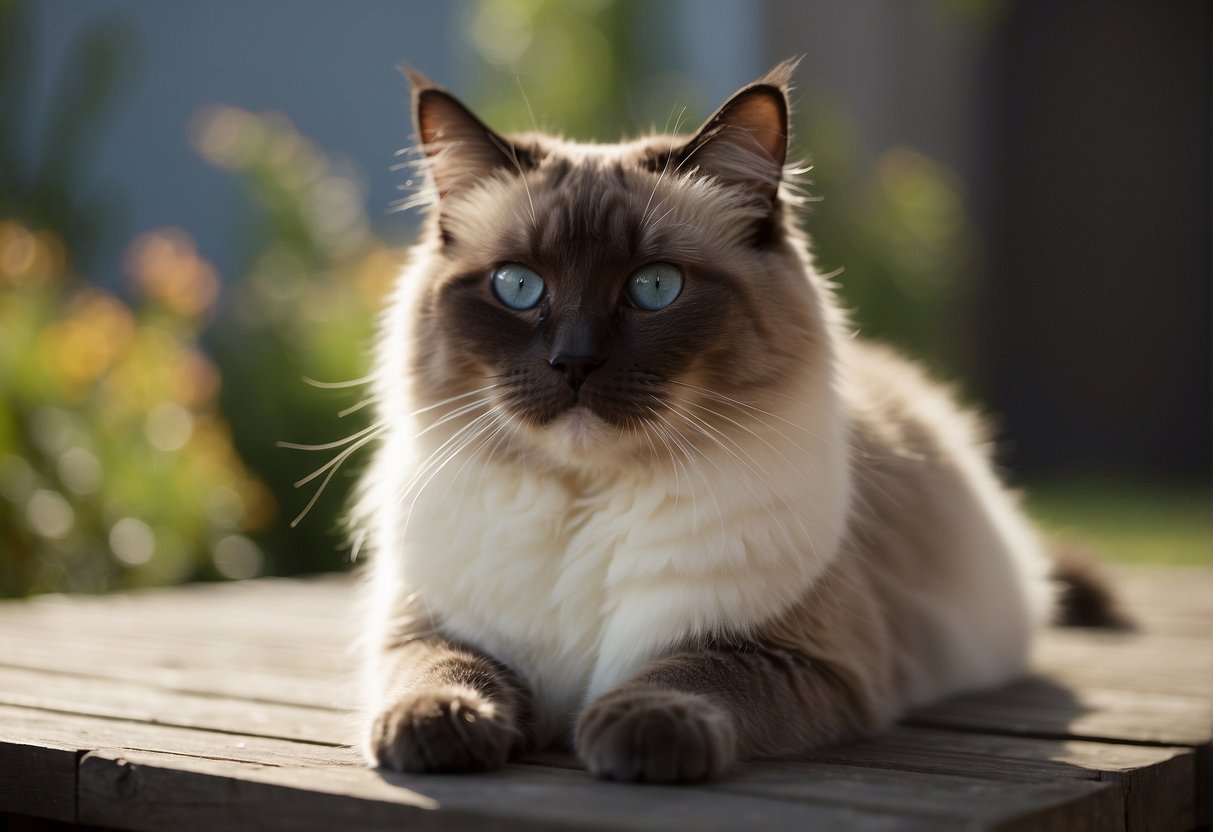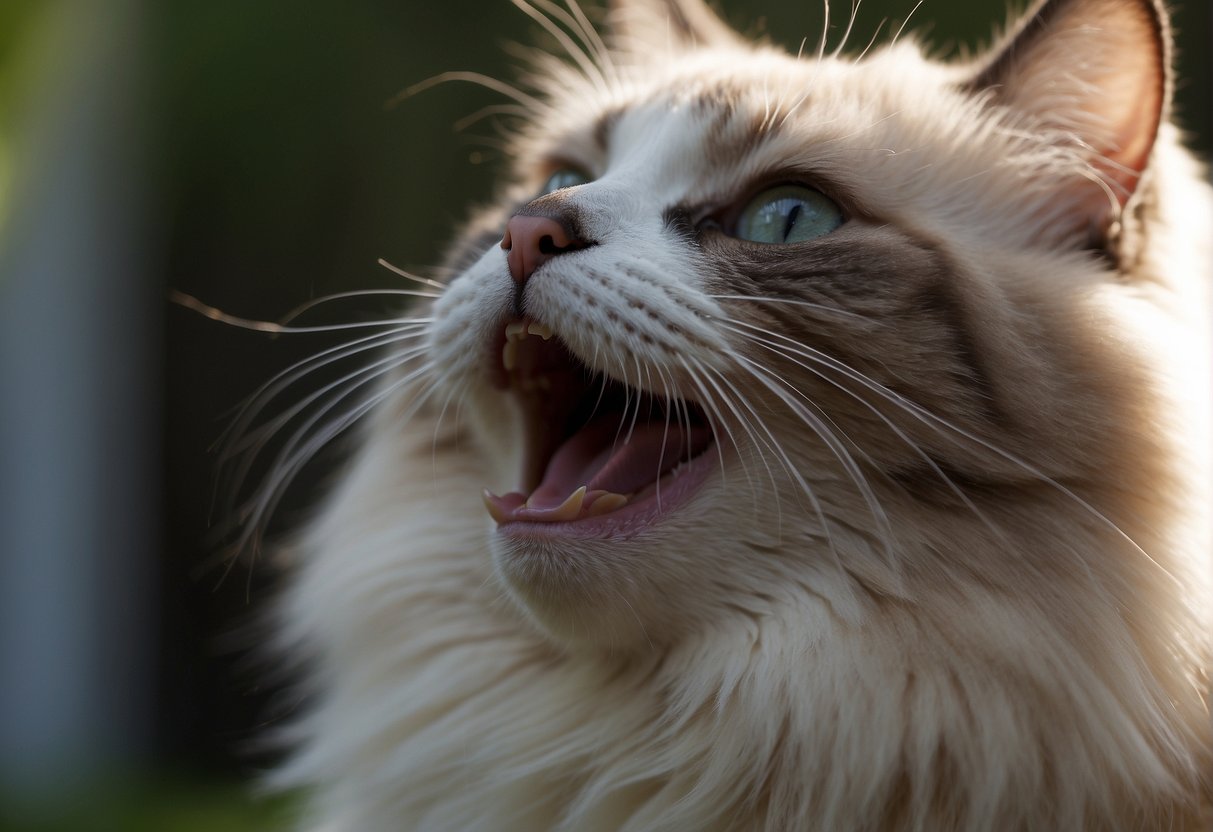Ragdoll cats, much like any other breed, go into heat several times a year if they are not spayed. Their heat cycle can begin as early as 4 to 9 months of age, and it’s a phase that every Ragdoll cat owner will need to manage.
When my cat experienced her first heat cycle, it was marked by increased affection and a noticeable change in behavior, like more vocalization and a bit of restlessness, which is typical for cats in this stage.

The heat cycle is crucial because it not only affects your Ragdoll’s behavior but also has implications for her health. The cycle can last from 7 to 10 days and will repeat every 2 to 3 weeks.
During this time, your Ragdoll might exhibit a range of reproductive behaviors such as rolling on the floor or actively seeking attention, which is their way of signaling readiness to mate.
Caring for a Ragdoll cat in heat involves keeping them comfortable and, if you’re not planning to breed, considering spaying before the first cycle to avoid unwanted pregnancies.
From my experiences, providing a calm environment and extra attention can help ease the stress your pet might feel. It’s all part of the journey of responsible and loving pet ownership.
The Heat Cycle in Ragdoll Cats

When considering Ragdoll cats, it’s essential to grasp the nuances of their heat cycles. These cycles are a crucial aspect of their reproductive process and can have significant effects on their behavior.
Stages of the Estrus Cycle
The estrus cycle of a Ragdoll cat consists of several stages, beginning with proestrus. This phase is short-lived, usually lasting 1 to 2 days, and is not always noticeable. Your Ragdoll won’t yet accept a mate but may display some mild behavioral changes; her vulva might swell slightly, and she could be more affectionate.
Following proestrus is estrus, commonly called ‘heat’. This is when your Ragdoll becomes receptive to mating. Signs of estrus include vocalization, increased affection, and more frequent rubbing against objects or people. Estrus lasts typically between 7-10 days.
Next is interestrus, a rest period if mating does not occur. If your Ragdoll cat has not mated, she will move into this stage before returning to estrus again.
Finally, there’s anestrus, the dormant stage of the reproductive cycle, which happens typically during the colder months with shorter daylight hours, when reproductive hormones are less active.
Factors Affecting the Frequency of Heat Cycles
Several factors can influence the frequency at which your Ragdoll cat enters heat. Primarily, daylight hours extend a significant effect, with longer daylight extending the likelihood of cycling in and out of heat. Typically, cats enter heat cycles during seasons with more daylight such as spring and fall.
Your Ragdoll’s overall health also plays a pivotal role. A healthy diet, regular exercise, and proper medical care contribute to regular heat cycles. Conversely, a cat that is not well may experience irregular cycles.
The age at which Ragdoll cats first go into heat can vary. Usually, they begin their reproductive cycles between 4 to 9 months old, but this can fluctuate due to individual health and genetic factors.
Monitoring these cycles is crucial, especially if you’re considering breeding or wish to prevent unwanted litters by spaying at an appropriate age.
Recognizing Signs of Heat in Your Ragdoll Cat
As a Ragdoll cat owner, it’s essential to recognize when your pet is in heat. This will help you provide the care they need during this period and manage their behavior better.
Physical and Behavioral Changes
Your Ragdoll cat will exhibit clear physical and behavioral changes when in heat. Behavioral changes may include increased affection, restlessness, and rolling on the ground. These signs indicate your Ragdoll is experiencing a heat cycle. You might also notice a swollen genital area, which is a physical sign of heat.
Keeping an eye on these changes can help you understand your Ragdoll’s reproductive cycle.
Vocalization and Affection
Ragdoll cats are known for their docile temperament, but when in heat they might vocalize more vigorously.
This often sounds like loud meowing or yowling as a call to potential mates. Increased affection is another sign; your Ragdoll may become more clingy, rubbing against you or furniture more insistently than usual.
They do this to spread their scent, which is also a form of marking. Vocalization and affection-seeking behavior illustrate your Ragdoll’s need for attention and may also be a way to signal their readiness to mate.
Managing Your Ragdoll Cat During Heat
When your Ragdoll cat enters her heat cycle, it’s important for you to provide extra care and comfort. Managing stress and preventing accidents becomes top priority.
Creating a Comfortable Environment
Your ragdoll cat needs a calm space of her own to reduce stress during her heat cycle. Here’s how you can create that:
- Bedding: Provide soft and clean bedding in a quiet corner. Your cat might choose unexpected places to rest, so consider multiple bedding options.
- Temperature: Keep your home at a comfortable temperature, as your cat may be more sensitive during this time.
- Toys & Activities: Physical play with toys can help distract her from the urge to seek a mate.
Adjustments to grooming routines might be necessary, as she could be fussier. Pay attention to her cues and respect her need for space or attention.
Preventing Unwanted Pregnancies
It’s crucial to take steps to prevent the possibility of your Ragdoll getting pregnant if you are not planning for kittens:
- Spaying: The permanent option is to spay your cat, which not only prevents unwanted pregnancies but also eliminates heat cycles altogether.
- Secure Environment: Ensure that your indoor space is secure and that your cat cannot escape outdoors to find a potential mate. Check windows, doors, and any other openings.
An unspayed Ragdoll cat in heat attracts unneutered males. Therefore, if you have other pets, particularly male cats, consider keeping them separated if they are not neutered. This will prevent any unwanted pregnancies and reduce stress for both your Ragdoll and your other pets.
A balanced diet and proper nutrition support her during a heat cycle, as her energy needs can increase.
Health and Breeding Considerations
Navigating through the health and breeding aspects of Ragdoll cat ownership can be quite a journey. Knowing when to spay or breed your cat, as well as the risks associated with frequent heat cycles, is paramount for maintaining their well-being and ensuring a responsible approach to pet ownership.
Risks Associated with Frequent Heat Cycles
Ragdoll cats, like other breeds, experience several heat cycles during the breeding season. Your Ragdoll can start going into heat as early as 4-6 months old and will continue to do so regularly, which can be a strain on her health.
Frequent heat cycles can lead to various health issues, including stress on the reproductive system and an increased risk of developing uterine cancer. Hormones during heats can also cause behavioral changes, and if a cat is not spayed and remains un-bred, complications such as a pyometra, an infection of the uterus, can occur.
Deciding to Spay or Breed
When considering spaying or breeding your Ragdoll cat, it’s important to weigh your options carefully. Spaying your cat generally eliminates the risks associated with the reproductive cycle by removing her uterus and ovaries.
This process not only prevents the discomfort of continuous heat cycles but also reduces the chance of unwanted litters of kittens and decreases the risk of ovarian and uterine cancer. If you’re considering breeding, consult with your veterinarian to understand the responsibilities and the health considerations involved.
Responsible breeding requires recognizing when your Ragdoll is mature and receptive, as well as providing proper care throughout the breeding process.

My name is James, and welcome to FAQCats!
Along with our team of cat owners, expert pet enthusiasts, and pet professionals, we aim to write engaging helpful, engaging content about cats. At FAQCats we strive to provide content that’s accurate and fun to read. Our team writes about everything related to cats; even the most complex of topics. Through extensive research and caring for our own fur-pals, we’re able to provide something cat owners worldwide will love. Have a look around, and leave us feedback anytime!

